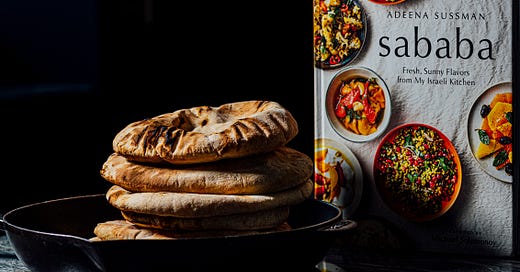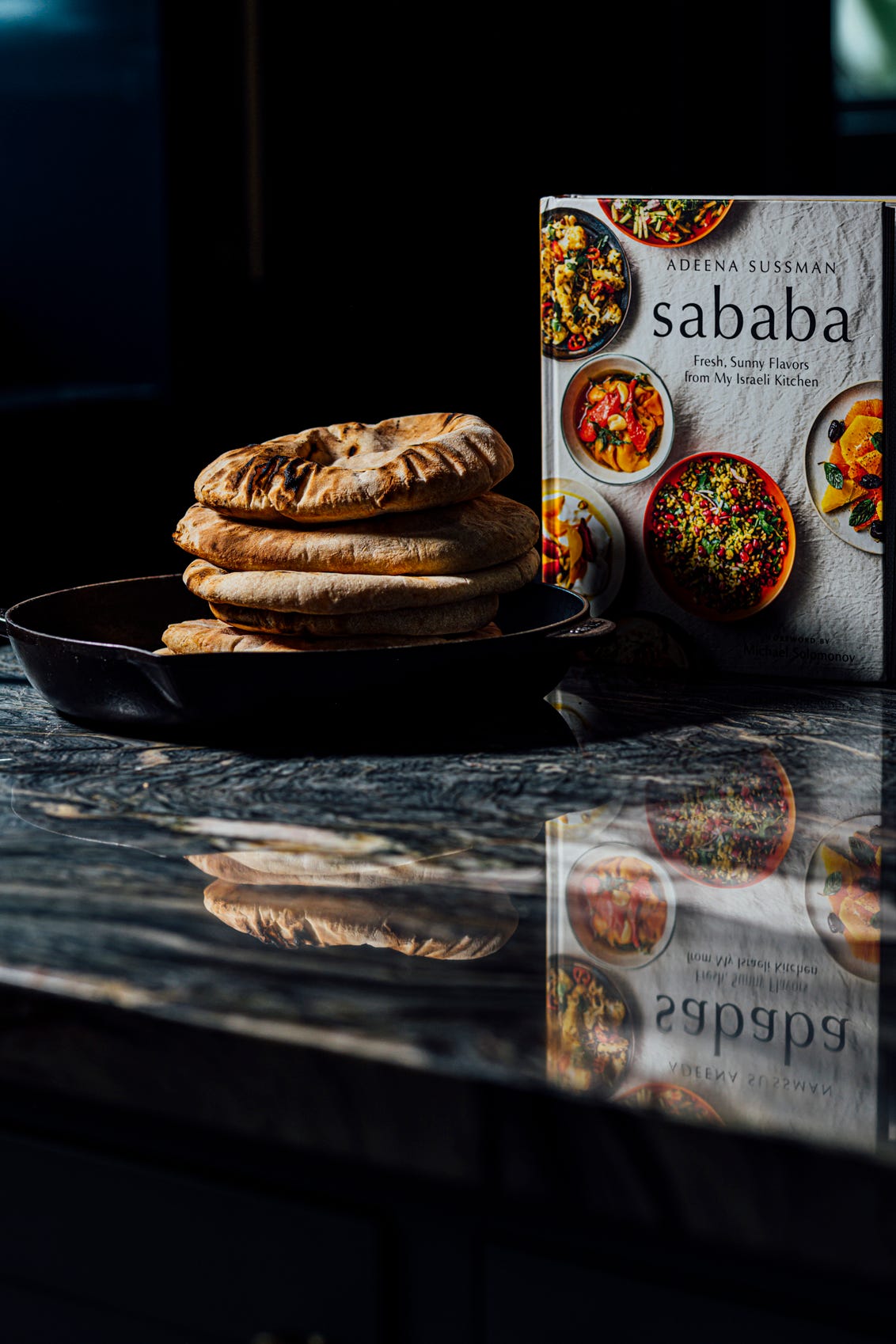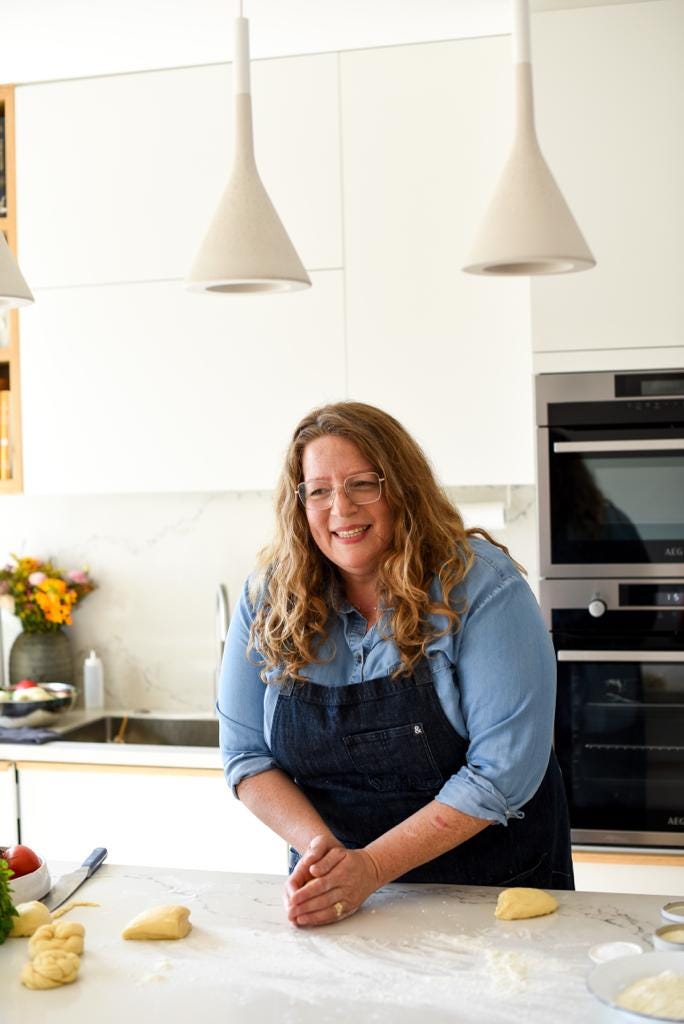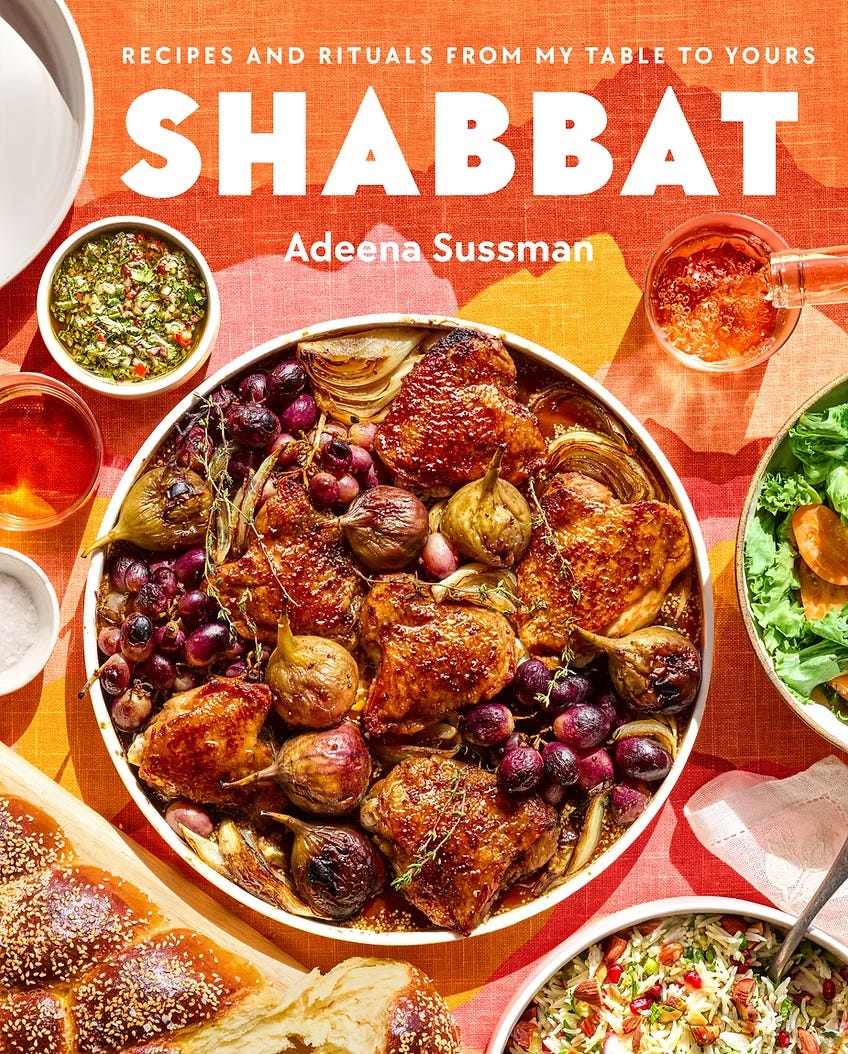Welcome to a new edition of The Flavor Files! I’m thrilled you’re here, and if you haven’t signed up yet, let me nudge you to join. Access to my recipes will always be free; use the Recipe Index to find something tasty. A special heartfelt thank you to all my paid subscribers who generously support my work, research, and this newsletter.
I’ve been on a quest to find and make pita perfectly at home, and fortunately, while sifting through my cookbooks, I came across one by Adeena Sussman in her book Sababa. It was easy to prepare, worked beautifully, and the results were perfect. It quickly became my go-to recipe, and I knew I must share it with you. I’ll warn you; you won’t like store-bought pita as much after trying Adeena’s recipe. I certainly have!
Sababa is a book full of life, bold flavors, and a visually colorful masterpiece. You’ll want to cook a lot out of this book. Believe me, I have. It’s a cook’s cookbook full of stories and Adeena’s journey from America to Israel. This book is a joyful treat to use in the kitchen, and Adeena’s expertise as a teacher and cook shines through the pages.
I’ve made some minor changes that you’ll notice in the video. I used a Baking Steel instead of my cast-iron skillet to cook the bread in the oven; it produced the same results. A pizza stone will also work great if you have one on hand. Another little tweak you’ll notice is my toasting the pita directly over an open flame using a roti jali. A roti jali is an Indian contraption, a big wire net with a handle used to toast flatbreads like rotis, and does wonders for tortillas. Get one; you won’t be sorry. One tip to remember when using a roti jali is to flip the bread quickly using a pair of metal tongs so it doesn’t burn.
Any leftover cooked pita can be frozen in an airtight ziptop bag for up to three months. When reheating, I first wet the thawed bread under running tap water and then place it into a heated oven (300F/150C) to warm up. This quick water rehydration spa therapy reintroduces moisture into the bread, keeps it soft and tender, and prevents the bread from drying out and turning crisp. It also works on stale sourdough.
I recently spoke with Adeena about all things cooking, chillies, Sababa, her upcoming cookbook, Shabbat, and more.
Nik: In Sababa, you talk about your move from America to Israel. What are some things you’ve loved about your new home, and what are some that you miss from America?
Adeena: I have absolutely loved the availability of fresh, seasonal produce and the emphasis on celebrating things at their peak. It’s less of an elitist proposition here in Israel than I experienced in the United States - it’s just how people eat. I love that the quality of food is very high on all levels - from the freshness of bread to a just-prepared breakfast sandwich to hummus joints that make a specific amount, then close for the day when it sells out. I love the directness of Israelis and the what-you-see-is-what-you-get approach to life, which I think also is reflected in the food here.
I miss excellent Asian and Mexican food (though they are improving), Central Park, and the Met.
Nik: The shuks feature prominently in your book. What’s your experience been like?
Adeena: The Carmel Market in Tel Aviv was my immediate entry point into Israeli culture - food and otherwise. My now-husband and I got a place steps away, and from day one, I was in there shopping, sniffing, prodding, asking questions, and making friends with vendors and purveyors. I still “touch the shuk” daily, even if I am not actually buying food. It is my touchstone and happy place. I am close with my spice vendor, butcher, Asian greengrocer, and, of course, the coffee shop owner. He knows my order long before I enter the door. I also love how the shuk is very multicultural. Many Arab Israelis and Palestinians work in the shuk, as well as asylum seekers from Sudan and Eritrea. They talk to me about their homes, their desire to either return there or settle permanently in Israel, and the foods they miss. I also learned that the Muslim, Coptic Christian, and Ethiopian holidays are based on who's not working on certain days.
Nik: What kind of hot peppers are commonly used in Israel? What are some of your favorites to cook with?
Adeena: The most common Israeli hot pepper is called shatta, a long, hot, bottle-green pepper. The Shifka is a small, light-green hot pepper from the banana pepper family that is often pickled and offered at street food stands. We also use jalapeños (though they are considered “gourmet” and are pricier. Slender, hot red peppers that look like fresh cayenne peppers are also common.
Nik: Let’s talk about your perfect pita recipe. It’s become my go-to recipe since I found it in your book. It does make all store-bought pitas pale in comparison. What was the process of developing that recipe like?
Adeena: Thank you! It was a process of figuring out how to bring the techniques that have become popular among street food stands and casual joints to the home kitchen. About 12 years ago, pita underwent a revolution in Israel; chefs decided it had to be as good as the things you stuffed inside and be able to hold drippy sauces, juicy fillings, and copious amounts of condiments. So they connected the dots between sourdough and pita, creating a sponge that bubbles and quick-ferments before adding the remaining flour and ingredients and rising, shaping, resting, and baking. It’s not hard, you just have to leave enough time - about 3 hours from start to finish.
Can we discuss that amazing pita cooking contraption that your stepdaughter, Shani’s father-in-law, Ezra Ovadia, uses?
Adeena: Don’t you just love how each country has its gadgets? That one is amazing! The key to good pita is lots of good heat all around it to get it to puff, and the coil on the top of that folding electric skillet ensures heat on the bottom (from the burner it sits on) and heat from the top (from the coil) all trapped in a hot, steamy environment. Israel also invented a “wonder pot,:” a sport of stove top Bundt pan used during the early years of the modern state when many people didn’t have an oven. Now they are collector’s items!
Nik: If there’s one condiment you can’t be without, what would it be? What’s an Israeli food you think we need to know about and try?
Adeena: Don’t make me choose between my babies, Nik! First, homemade preserved lemons. They’ve got funk, pucker, umami, and versatility, and they make you feel like a talented North African pantry-stocker with very little effort. These require more patience than talent - waiting for the skins to soften and be ready to use can be torture come lemon season.
I will choose a second - schug. It’s an eminently versatile Yemenite hot sauce that everyone in Israel has in their fridge. Garlic, hot chilies, parsley, cilantro, black pepper, cumin, and salt are blended into a paste of varying levels of heat depending on how brave you are (and how hot your peppers are). I stir it into soups and stews, dressings, and marinades, use it as a sandwich spread, and basically apply it wherever there is some available surface area on a grilled piece of meat, fish, or chicken. It brings food alive!
Nik: You’ve got a new cookbook in the works. Tell us more about it.
Adeena: It’s called Shabbat: Recipes and Rituals From My Kitchen To Yours. It’s a very personal reflection on how I cook on weekends, based on the ancient Jewish day of rest but modernized for the way I like to cook and entertain. It’s a combination of Sababa-style recipes (lots of fresh salads and dips, Middle Eastern flavors) along with many traditional families learned at the feet of my late mother, Steffi, and my paternal grandmother, Mildred - both great cooks. I also tell stories of Shabbat across the many walks of life here. I worked with the same team that photographed Sababa, and the pictures are absolutely GORGEOUS! Can’t wait for everyone to cook from the book!
Now, isn’t that cover gorgeous? Go check out Adeena’s cookbooks and work and preorder her new cookbook, Shabbat (September 5, 2023).
Until next time,
xx
Nik






Recipe?
Thank you, looking forward to trying this!